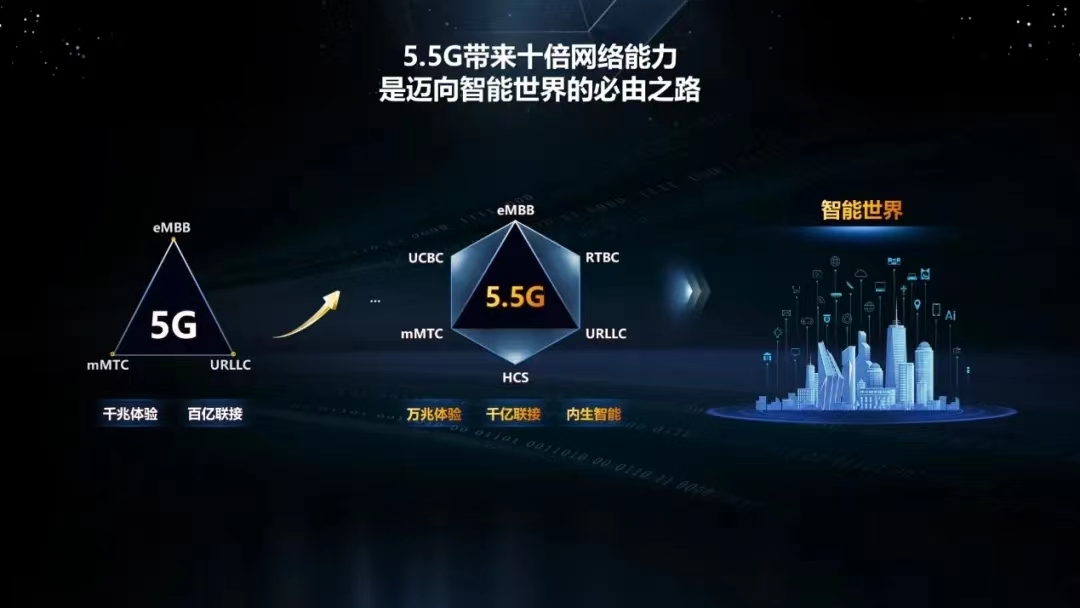The 5.5G industry will speed up again! Qualcomm's 5G Advanced-ready chip commercial terminal will be available in the second half of the year

The 5.5G industry will speed up again! Qualcomm's 5G Advanced-ready chip commercial terminal will be available in the second half of the year
The MWC 2023 conference is coming soon, and the 5G Advanced industry has another big news! On February 15, Qualcomm announced the launch of the world's first 5G Advanced-ready baseband chip - Snapdragon® X75 5G modem and RF system, which supports millet wa and Sub-6GHz frequency bands, bringing network coverage, latency, energy efficiency and mobility It is necessary to set a new benchmark for smartphone connection through all-round improvement.
As we all know, 5G Advanced is the next stage of 5G technology evolution. Its most notable feature is that it can bring ten times the current network capacity, such as increasing the download rate of mobile users from Gbps to 10Gbps to support XR Pro and Yuan UWB real-time interactive applications such as the universe . In addition, 5G Advanced also has the characteristics of supporting Gigabit uplink and 100 billion Internet of Things, fully meeting the needs of various industries and industries for a leap in experience and deepening digital and intelligent transformation.
Everyone in the industry knows that terminals come first in network development. The release of 5G Advanced-ready chips means that the development of the 5G Advanced terminal industry will be fully accelerated, thereby accelerating the scale development of 5G no Advanced networks . that "Snapdragon X75 is currently sampling, and commercial terminals are expected to be released in the second half of 2023." Previously, the industry expected that 5G Advanced networks would be commercially available in 2024 at the earliest.
At the same time, it is worth noting that the 5G Advanced-ready chip released by Qualcomm not only supports a faster mobile phone connection experience, but also provides services for vertical industries (automotive, PC and industrial Internet of Things) and FWA (Fixed Wireless Access) scenarios. , This means that terminal manufacturers in the personal, industry and household markets will all benefit from it, and promote the comprehensive and accelerated development of the entire 5G Advanced industrial ecology.
Continuous evolution, 5G Advanced technology standard breakthrough
The wireless industry has developed in an orderly and vigorous manner over the past 30 years, and the key reason behind it is vision leadership and continuous iteration. From 1G to 5G, the wireless industry has basically followed the ten-year development law, and it has also continued to evolve in each major generation. 5G Advanced is the product of the continuous evolution of 5G under this law.
In 2020, the 5.5G industrial vision of 5G evolution was proposed by the industry for the first time. In April 2021, 3GPP officially determined the name of 5G evolution as 5G-Advanced, and started the standardization process. It plans to define 5G-Advanced technical specifications through three versions, R18, R19, and R20. At the end of 2021, the first batch of 28 projects of R18 will be approved, and 5.5G technology research and standardization will enter a substantive stage. Future R19 and R20 versions will further explore new 5.5G services and architectures.
Under the common vision of the industry, the current 5G-Advanced has basically formed key capabilities such as 10Gbps downlink, 1Gbps uplink, millisecond-level latency, 100 billion connections, and communication-aware integration for 2025, bringing ten times the current The network capability greatly improves the user experience in various scenarios. For more than two years, the industry has done a lot of work in 5G Advanced technology innovation, and has made key breakthroughs in multiple technical standard fields.

Among them, in terms of the most representative downlink 10Gbps target network characteristics of 5G Advanced, industry pioneers have made significant progress.
At the end of December 2022, China Mobile and its industry partners released the Yearbook of 5G-Advanced Dual-chain Integration, showing the industry's first batch of 5G-Advanced end-to-end industry models jointly created by multiple parties. Among them, in terms of XR business, China Mobile joined hands with Huawei and Migu to complete the industry's first "X-Layer cross-layer integration" technology terminal network cloud industry four-in-one industry test. The test results show that the 100M bandwidth single sector based on China Mobile's 4.9GHz frequency band can support 20 XR terminal systems at the same time, and the capacity has been increased by 5 times . and millisecond-level low-latency requirements.
In addition, in terms of 5G Advanced target network characteristics such as uplink 1Gbps, 100 billion connections, and synesthesia integration, industry pioneers have also actively explored and achieved fruitful results.
In May 2022, China Telecom and Huawei took the lead in demonstrating the laboratory test and verification results of the "super time-frequency folding" 5G-Advanced innovative technology. Based on the 3.5GHz frequency band test, the uplink equivalent bandwidth of this technology is as high as 100MHz, and can achieve an uplink peak rate exceeding 1Gbps. At the same time, the end-to-end delay is shortened from 10ms to less than 4ms, which fully meets the core needs of remote control and machine collaboration. The production process has strict requirements for large network bandwidth, low latency, and reliability.
Also in May 2022, China Unicom will hold a press conference on scientific and technological innovation and practical achievements, and join hands with industry partners to jointly release the innovative achievements of 5G evolution and officially launch the technological innovation industry cooperation plan. Among them, in the field of smart super-sensing, China Unicom has realized a 1-kilometer sensing distance and sub-meter-level sensing accuracy based on base stations in the direction of communication-sensing integration, and realized an air interface delay line of 4ms in the direction of URLLC, while 99.999% of the delay is stable. sex.
At the same time, under the guidance of the IMT-2020 (5G) promotion group, equipment manufacturers represented by Huawei have actively participated in the testing and verification of 5G enhanced technology, and have successively completed high-precision timing, 5G LAN, 5G synaesthesia, and 5G medium and high-speed IoT. Networking (RedCap), mmWave FR-only networking, low-latency high-reliability (URLLC) and other test verifications continue to enrich 5G enhanced technical capabilities.
Terminals are ready to help accelerate the development of the 5G Advanced industry
Judging from the development experience of 3G, 4G, and 5G, in the era of mobile Internet where experience is king, operators' network leadership is inseparable from the rapid progress of network construction and the advance planning of terminal layout. At present, the industry agrees that after nearly three years of advancement, 5G-Advanced has entered a new stage of development, and it is time to make product preparations and jointly mature the end-die industry chain.
In order to match the 5G Advanced target network characteristics represented by the following 10Gbps, the industry generally believes that 5G-Advanced chips and smart terminals need to move towards 3T8R or even more channels, and support carrier aggregation of more than 4 carriers to create a 10G experience terminal in order to fully Unleash 10 Gigabit capabilities to meet the needs of future services such as XR and Metaverse.
The 5G Advanced-ready baseband chip released by Qualcomm this time has been reflected in these aspects. For example, its mobile-oriented products adopt ten-carrier aggregation in the millimeter wave frequency band, and support downlink five-carrier aggregation and FDD uplink MIMO in the Sub-6GHz frequency band, which can achieve excellent spectrum aggregation and capacity performance; products for FWA scenarios not only support mm Wave, Sub-6GHz, and also supports Wi-Fi 7 and 10Gb Ethernet capabilities, which can realize the network peak rate.
With reference to the development history of 5G, it can be found that global operators, including China's three major operators, have adopted a terminal-first strategy, including but not limited to stimulating the rapid development of the terminal industry in terms of technical standards, product research and development, and ecological construction, so that advanced networks Resonate with the same frequency as various terminals. Needless to say, more advanced 5G Advanced networks also need to take corresponding measures to promote the readiness of 5G baseband chips to enable mobile phones, automobiles, AR/VR, CPE and other smart terminals.
According to the forecast of ABI Research, the migration to 5G-Advanced will reshape the mobile and wearable device market. In 2024, 4.9 million 5G-Advanced compatible mobile devices will be shipped. It will reach 481.9 million units in 2027. The rapid increase of 5G-Advanced terminal equipment will surely help the scale development of 5G-Advanced network and create a prosperous 5G-Advanced industrial ecology.
On the side of network equipment corresponding to user terminals, as the industry has made great progress in 5G Advanced standards, spectrum, and technology, we can see ultra-large bandwidth, ELAA-MM, uplink and downlink decoupling, and multi-frequency integration. , RedCap, NB-IoT, Passive IoT and other technical fields are constantly innovating and breaking through, gradually gathering the comprehensive capabilities required to build a 5G Advanced network, which can help operators match the capabilities of the network and terminals, and lead the development of the 5G Advanced industry. Maximize the ability to unleash advanced networks.
It is reported that at the upcoming MWC 2023 conference in Barcelona, 5G Advanced will also be one of the key topics, and many industry giants will take the stage to share the latest progress of 5G Advanced. We believe that as long as the global industrial chain partners continue to innovate around 5G Advanced standards, spectrum, products, ecology, and applications, and build an industrial ecosystem with an open, cooperative, and win-win mentality, we will soon see the arrival of more advanced 5.5G!